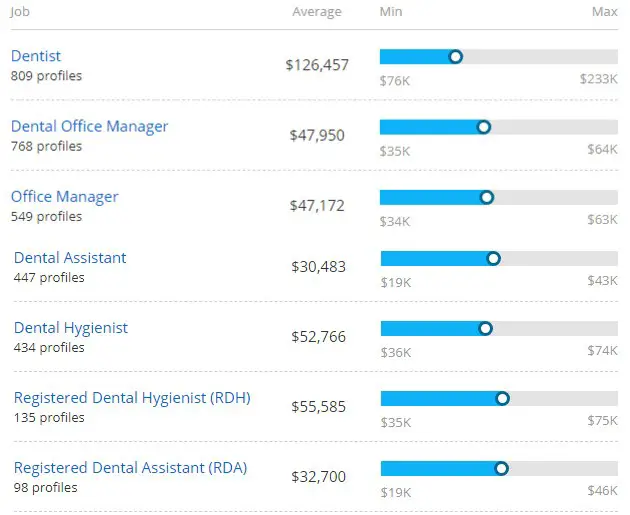How to become a Dental Assistant
This article provides in-depth information into What is a Dental Assistant? What Dental Assistants do? Degrees for Dental Assistants, Steps to become Dental Assistant and much more.
Oral care is just as important as any other form of healthcare when we talk about medicine. Much like how each doctor has an assistant to help them with complex routines and operations, a general dentist will require aid in their practices. Becoming a Dental Assistant allows you to take up these opportunities.
What does a Dental Assistant do ?
A dental assistant is a jack-of-all-trades who takes up multiple responsibilities that a dentist would have; patient care, x-rays, handling equipment, reading data, records keeping and assigning appointments, schedules, and prescriptions to patients. In essence, an assistant would spend most of their day working closely with the dentist in caring for the patient. They may also document entire procedures during appointments and operations.
Depending on the state you are living in, there is a regulation regarding the scope of an assistant’s professional capabilities. Some states entrust assistants to apply for oral medicines and even treat the patient’s plaque or stains. Others keep their roles strictly subordinate to the dentist.
Steps for becoming a Dental Assistant
1
Get A Higher Education
Like any profession related to medicine, it’s important for a candidate to complete a designated program that specializes in this particular field. Dental assisting programs take about a year for completion, but it’s encouraged to take up degree courses.
Degree courses that stretch up to 2 years are considered an Associate’s program. However, it’s uncommon for dental assistants to take up this course as they may look forward to climbing the ladders and becoming dentists themselves. In which case, higher programs are beneficial.
Such programs are better pursued in either technical schools or community colleges as work experience is more valued, therefore there is no need to spend too much on education unless you are willing to pursue a Master’s degree or a Doctorate.
2
Learn On-the-job
If a candidate does not have any formal training in dental assistance, they may learn them from the beginning of the start of their career as one. They will learn all kinds of terminologies related to oral hygiene, how to complete important tasks and prioritize emergent cases, how to care for a patient when a supervisor or a dentist isn’t present, and how to keep an eye on other tasks at hand, such as incoming patients, registration and even equipment sterilization.
3
Do An Externship
An externship is a short period (usually a few weeks) during which a candidate may ‘shadow’ their superiors and other professionals in their daily tasks to have a healthy understanding of the career they wish to pursue. Generally, candidates neither get paid nor do they get any credits for their externship efforts, but the experience gained from it can be of immense value to their future endeavors. They may carve their skills on almost all the possible aspects of dentistry to get a feel of what each component can bring to the table so that they may, in time, make the appropriate career choice.
4
Take Up A Certification Course
Requirements for certification are dependent on the state you are living in. In the cases of it being a necessity, the candidate must take up the certification examination conducted by the Dental Assistant National Board (DANB). Candidates must be present at the VUE test centers and complete it.
There are five different national-level certifications offered by the DANB, each of which consists of three concentrations on an average:
-
National Entry Level Dental Assistant (NELDA)
-
Anatomy, Morphology, and Physiology (AMP)
-
Infection Control (ICE)
-
Radiation Health and Safety (RHS)
The interesting aspect about NELDA is that it also contains further dedicated (but optional) certifications for students who want to work in specialized dental assisting, such as Orthodontic Dental Assistant, Preventive Functions Dental Assistant, and finally, Restorative Functions Dental Assistant.
Certified Dental Assistant (CDA)
-
General Chairside Assisting (GC)
-
Radiation Health and Safety (RHS)
-
Infection Control (ICE)
Certified Orthodontic Assistant (COA)
-
Orthodontic Assisting (OA)
-
Infection Control (ICE)
Certified Preventive Functions Dental Assistant (CPFDA)
-
Coronal Polishing (CP)
-
Sealants (SE)
-
Topical Fluoride (TF)
Certified Restorative Functions Dental Assistant (CRFDA)
-
Impressions (IM)
-
Sealants (SE)
-
Temporaries (TMP)
-
Restorative Functions (RF)
5
Internship Or Entry-level Opportunities
Work experience is valued in almost any industry. With that said, experience in handling dental assisting responsibilities can come off as a gold mine in your portfolio. Dental assisting is a fast-growing career, and so taking up entry-level opportunities can not only teach you the ins and outs of the career, but the experience gained can also help sculpt a way forward in your career as a designated assistant and bolster your chances of securing a position in highly trusted medical centers.
If you want to nudge your career mobility, you may opt for additional schooling; advanced degrees are available for those willing to pave their way to increase the chances of further career possibilities. Candidates with an associate degree can transfer their credits to a bachelor’s degree in dental hygiene.
6
Obtain A License
Those wanting to become a licensed Dental Assistant may apply for examinations listed under the DANB. The requirements to obtain a license may vary according to each state. In order to meet eligibility requirements, you may take one of the following approaches:
Approach I
-
The candidate must be a graduate from an accredited dental assisting or dental hygiene program.
-
The candidate must provide current CPR certifications from an approved CPR provider.
Approach II
-
The candidate must be (former) CDA certification holders or should have graduated from an accredited doctoral dental program.
-
The candidate must provide current CPR certifications from an approved CPR provider.
Approach III
-
The candidate must hold a high school diploma or similar certification.
-
The candidate must have at least 2-4 years of experience as a Dental Assistant with an accumulation of up to at least 3,500 working hours, with a verified dentist verifying the employment details.
-
The candidate must provide current CPR certifications from an approved CPR provider.
Dental Assistant Degree Levels
Certificate
The certification courses help in acquiring skills and specialized knowledge in the subject chosen as well demonstrate our competence which makes you more employable and marketable in the competitive world. Also, certification courses can be pursued online and at an accelerated rate which may take about a few months.
Oral anatomy
-
Oral cavity
-
Surrounding facial structure
-
Anesthesia, mastication, and occlusion
Objectives
-
Identifying oral anatomical features
-
Understanding anatomical variations
-
Applying knowledge to clinical setting
Radiography
-
Digital dental radiography
-
X-ray techniques
-
Radiographic Procedures
Objectives
-
Positioning X-ray for best results
-
Recognizing usable versus unusable images
-
Developing awareness of latest radiographic technology
Clinical dental assisting
-
Common assisting skills
-
Rotational schedule
-
Basic technical skills
Objectives
-
Practicing assisting functions
-
Understanding emergency procedures
-
Developing professional and ethical assisting skills
Associate
Generally speaking, completing and performing competitively well in a one-year-long accredited program in a community college or a technical school, coupled with quality work experience, can help boost their value as a dental assistant in many dental practices.
However, any program that the candidate has to spend 2 years or less learning is uncommon and can lead to an Associate’s degree. These programs will teach students how to provide dentists administrative and chairside assistance in their offices. Practical tasks, oral health, medical science, and professional demeanor are all essential parts, along with some knowledge on liberal arts.
Some programs taught in community colleges or technical schools mostly fall under the Voc-Tech (Vocational/Technical) programs, which are not accredited by the Commission on Dental Accreditation (CODA); of the American Dental Association (ADA).
Candidates are encouraged to take up programs accredited by the CODA, and those who wish to be nationally certified can take up any certification exam under the DANB.
Dental materials
-
Cement and porcelain
-
Bonding agents
-
Metals and implants
Objectives
-
Evaluating correct materials to use for procedures
-
Establishing proper application techniques
-
Understanding properties of individual materials
Pharmacology and radiology
-
Production of x-rays
-
Radiation protection
-
Digital imaging
Objectives
- Proper patient identification
-
The correct method of obtaining patient’s vital signs
- Darkroom techniques
Business administration
-
Data Analysis
-
Financial Accounting
-
Cost Accounting
Objectives
-
Effectively communicate with customers
-
Collaborate in a business environment
-
Use data to engage in effective decision-making
Salary
It is estimated by the U.S. Bureau of Labor Statistics that the median annual wage for dental assistance from all sectors was $38,660 since 2018. In government sectors, the median wage goes slightly beyond that, with the numbers floating around the approximate value of $42,390 per annum. In private sectors, such as offices of physicians and independent dental practices, the average median wages have stood around $35,760 to $38,670, respectively.
Part-time assistants usually spend their work hours in the evenings or at the weekends whereas most of the others work full-time.
Job Growth of a Dental Assistant
The career prospects are expected to grow by at least 11% within the decade; from 2018 to 2028. Comparatively, it is the fastest-growing average of all the careers. Due to the importance of oral hygiene today, and the scientific linkage between it and general health, baby-boomers are very likely to approach dentists for medical advice and help, thereby projecting an increased call for new talents practicing dentistry.
Job Concentrations for a dental assistant
Dental Hygienists
Dental Hygienists usually act as right-hand personnel to the dentists, as they work closely with the latter to meet patients’ oral health needs. But just like most other careers, these responsibilities can vary according to whichever state you are interested in working in. They are most demanded in general dental practices and in periodontics and pediatric dentistry. However, specialized demands occur within public hospitals, the Armed Forces, dental schools, and large organizations.
As there is a rise in the number of people from the older generation who pay attention to their oral health, dentists are creating opportunities for aspiring hygienists to meet the demand of dental services.
Dental Laboratory Technicians
It’s important for dentists to utilize the appropriate equipment to treat their patient’s dental issues. But the design and implementation of the equipment themselves come from Dental Laboratory Technicians. Although it’s rare for a Laboratory Technician to engage with the patients themselves, they are valuable in partaking in sessions with the dental operations team as they help design and create apparatus that either the dentist or the patient may use, such as dentures and braces. They usually work under the direction of a licensed dentist and follow the instructions noted down by them.
Veterinary Assistants / Laboratory Animal Caretakers
Assistants who wish to empathize with animals can help with offering their services to veterinarian practices, taking up responsibilities such as completing daily routine tasks, pet diagnosis, tartar elimination, and other general tasks given under the supervision of veterinarian experts.
Career Preparations
Volunteering Prior to Schooling
By giving yourself an idea of the profession, it gives you a head start on what to expect when first joining a dental assisting course. You gain a much better understanding of the dental procedures, and witness methods and techniques used by licensed dentists and practice them during the course, and learn more about infection control as well as the rules and regulations regarding the patient’s safety.
Obtain a certification
In order to obtain a certification, you must obtain a CPR certification as well as satisfy at least one of the following requirements:
-
Graduate from an accredited dental assisting or hygiene program.
-
Obtain a minimum of 3,500 hours of work experience verified by a licensed dentist, and hold a high school diploma or equivalent.
-
Previously held DANB CDA status, or have graduated from an accredited DDS or DMD program, or graduated from a dental degree program abroad.
The minimum score required to be certified is 400 points, but it is encouraged to perform better than the required cut-off if they want to stand out of the competition and receive potentially career-defining opportunities.
Completing more training modules or courses can help alleviate the possibility of failure, but should the candidate fail to obtain sufficient points, they may retake the examination. Some states may make it necessary for the candidate to dabble in additional coursework to qualify for a re-examination.
Obtain a Cardiopulmonary Resuscitation (CPR) Certification
It is necessary for every individual practicing dentistry to have profound knowledge of CPR with a BLS Provider certification, provided by the American Heart Association. It teaches topics such as checking early signs, warnings, and responses, EMS handling, assistance in choking alleviation, basic Automated External Defibrillator (AED) operation, hand-eye coordination, breathing (mouth-to-mouth, bag-mask device) and all-round skills with different persons (adult, child, infant).
Since it is important to keep the certificate up to date, you are required to take it every 2 years.
Prominent Skills of a Dental Assistant
Multitasking: Dental Assistants will constantly be on a rush for assisting their superiors and mentors. It’s necessary for them to optimize the dentist’s workflow by keeping appointments, caring for patients, and following the necessary protocols and safety regulations to maintain consistency with the profession’s medical assurances. In order to achieve this, assistants must get used to the daily hustle and adopt a multitasking mindset.
Precision: Since Dental Assistants will be required to work with patients once a while, it’s impertinent for them to keep steady when operating with medical apparatus and other equipment, especially since they will be working on delicate spots of the body. This ensures precise attempts without any discomfort among those involved, most importantly, the patients.
Communicative: Since dentists will be assigning daily tasks to the assistants, it’s up to the assistants to finish them as efficiently as possible. This will require a lot of two-way communication between them to minimize or prevent any confusion, interruptions errors from either side. They must also be good listeners as they will have to pay attention to a number of routines an average dentist would normally have to pay attention to, such as taking X-rays or making appointments.
Empathy: Since a lot of patients can be difficult to handle, it’s necessary for an assistant to practice empathy control. Assistants will have to learn the concepts of pain and fear management in patients and have a good understanding of how their actions can best provide a positive experience for them. Chairside manners are also integral in the role of a dental assistant.
Technical Skills: Sometimes, the assistants won’t always be dealing with dental responsibilities; they will also need to understand technical equipment they may have to utilize during their daily routines. Automating appointments and preparing the right equipment for incoming patients are some of those tasks.
| Minumum Credit Score | Apply in as little as | Variable APR | Fixed APR | ||
|---|---|---|---|---|---|
 | Not Available | 15 minutes or less | 2.95 | 4.74 | View disclosures |
 | 620 | 2 minutes | 5.38%-16.99%1 | 4.43%-16.99%1 | View disclosures |
 | Not Available | 15 minutes | 1.13% - 11.23%¹ (with autopay) | 3.50% - 12.60%¹ (with autopay) | View disclosures |
